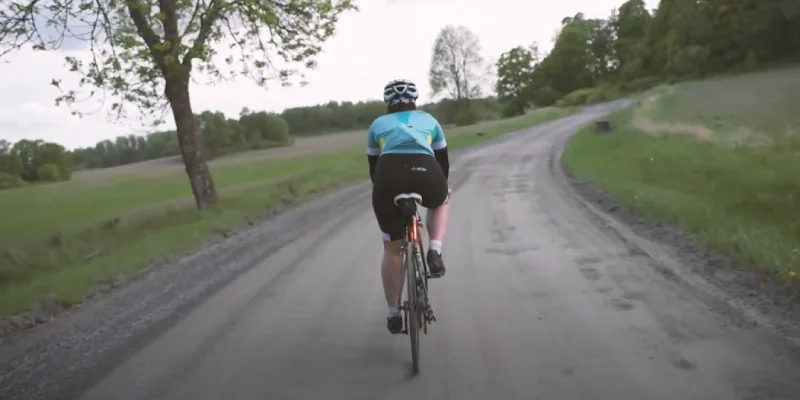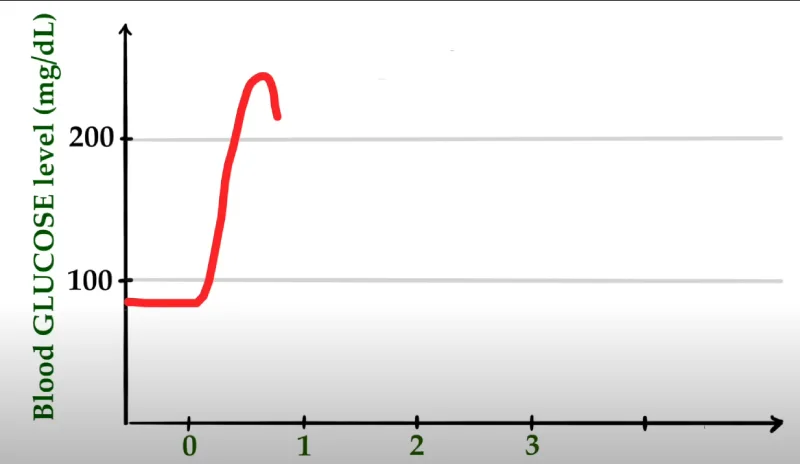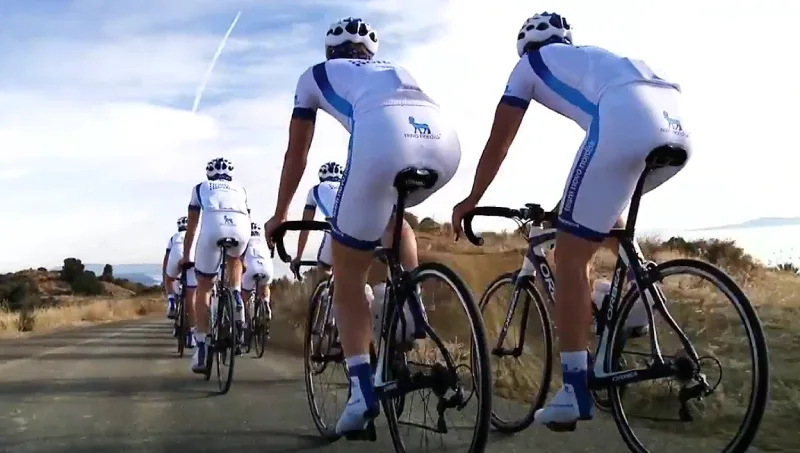While exercising, cyclists should track their blood sugar levels to prevent hypoglycemia, which can lead to fatigue and decreased performance. Furthermore, they should steer clear of hyperglycemia, as it may result in dehydration and pose long-term health risks.
An hour of moderate cycling can halve blood sugar levels in overweight cyclists with diabetes within the next 24 hours. If you cycle faster for half an hour, your levels can be reduced by 19% for an entire day.
In this blog post we will explore 13 Scientific Explanation of Cycling Lowers Blood Sugar. Also Provide The 9 Factors of Sugar Reduction and 14 Tips for Managing Blood Sugar While Cycling.
How Much Does Cycling Lower Blood Sugar: 13 Scientific Explanation

Cycling has a notable effect on blood sugar levels because of its aerobic intensity. By increasing glucose absorption in muscles, it helps manage blood sugar more effectively. Exploring the physiological aspects of cycling unveils the intricate processes that collaborate to decrease blood sugar levels. Through heightened muscle engagement and enhanced circulation, cycling significantly contributes to blood sugar regulation.
How Does Cycling Impact Blood Sugar Levels?
Cycling, as an aerobic exercise, exerts a profound impact on blood sugar levels. The activity facilitates enhanced glucose uptake by muscles, promoting better blood sugar management. To understand this process, it’s essential to delve into the physiological mechanisms at play during cycling.
Explanation of the Physiological Processes
When you engage in cycling, several physiological processes come into action that collectively help in lowering blood sugar levels:
Increased Muscle Activity:
- During cycling, muscle contractions increase, leading to a higher demand for glucose as a fuel source.
- Glucose is transported from the bloodstream into muscle cells, thereby reducing blood glucose levels.
Enhanced Circulation:
- Cycling improves overall blood flow, ensuring efficient delivery of glucose and oxygen to active muscles.
- Better circulation also assists in the removal of metabolic by-products.
Hormonal Regulation:
- In response to exercise, the body releases hormones like adrenaline and noradrenaline, which help in mobilizing glucose reserves.
- This hormonal response ensures a steady supply of glucose during prolonged cycling sessions.
Role of Insulin Sensitivity and Glucose Uptake
Insulin sensitivity and glucose uptake play pivotal roles in how cycling affects blood sugar levels. Here’s how they contribute:
Improvement in Insulin Sensitivity:
- Regular cycling enhances insulin sensitivity, meaning less insulin is needed to maintain blood sugar levels.
- Improvements in insulin sensitivity can reduce type 2 diabetes risk.
Augmented Glucose Uptake:
- Cycling activates GLUT4 transporters, which facilitate the movement of glucose into muscle cells.
- This increased glucose uptake helps in maintaining lower blood sugar levels post-exercise.
Glycogen Storage:
- Glycogen is the form of glucose that is stored in muscles. During cycling, glycogen stores are utilized and subsequently replenished, helping regulate blood sugar levels over time.
- Efficient glycogen storage and usage contribute to sustained energy levels and better glucose control.
Understanding these physiological processes and insulin sensitivity’s role in glucose uptake shows how cycling effectively manages blood sugar. Regular cycling provides immediate benefits and enhances long-term metabolic health.
Benefits of Cycling for Blood Sugar Management

A bike ride is more than a recreational activity; it can help you manage blood sugar levels efficiently. For healthy blood sugar management, the benefits of cycling can be observed both immediately and over the long term. Understanding these impacts can help individuals leverage cycling as a strategic exercise for better metabolic health.
Immediate Effects on Blood Sugar Levels
Engaging in a cycling session can have immediate positive effects on blood sugar levels. The glucose levels of cyclists who need to be managed efficiently.
Rapid Glucose Utilization:
- During cycling, muscles quickly utilize glucose for energy, decreasing blood sugar levels.
- This immediate uptake helps in preventing post-meal blood sugar spikes.
Insulin-Independent Glucose Uptake:
- Exercise stimulates glucose uptake by muscles independently of insulin.
- This mechanism is beneficial for those with insulin resistance or reduced insulin sensitivity.
Enhanced Circulation:
- Improved blood circulation during cycling ensures that glucose is efficiently delivered to muscle cells where it is needed most.
- Enhanced circulation aids in the swift removal of excess glucose from the bloodstream.
Long-Term Benefits for Diabetes Prevention and Management
Regular cycling brings about long-term improvements in blood sugar control, making it an essential component of diabetes prevention and management strategies.
Enhanced Insulin Sensitivity:
- Consistent cycling improves the body’s responsiveness to insulin, lowering blood sugar levels with less insulin.
- Enhanced insulin sensitivity is crucial for preventing the onset of type 2 diabetes.
Sustained Weight Loss:
- Cycling contributes to weight loss and maintenance, which is a critical factor in diabetes management.
- Reduced body fat improves insulin sensitivity and lowers the risk of developing diabetes-related complications.
Improved Glycemic Control:
- Long-term cycling helps in maintaining stable blood sugar levels, reducing the frequency and severity of hyperglycemic episodes.
- Better glycemic control contributes to overall metabolic health and reduces the risk of long-term complications.
Cardiovascular Health:
- Regular cycling strengthens the cardiovascular system, enhancing health and reducing the likelihood of heart disease, which is often associated with diabetes.
- Improved cardiovascular health supports better overall blood circulation and glucose metabolism.
Cycling and Blood Sugar Reduction: 9 Factors to Consider
It is known that the blood sugar impact of cycling is dependent on variables such as intensity and duration. Customizing cycling workouts according to these variables can enhance blood sugar control. It is crucial to grasp the impact of varying intensities on glucose metabolism and insulin sensitivity.
Intensity and Duration of Cycling
The intensity and duration of cycling play pivotal roles in determining how effectively it can reduce blood sugar levels. Understanding these factors helps in tailoring cycling routines to maximize the benefits for blood sugar management.
How Different Intensities Affect Blood Sugar
The intensity at which you cycle can significantly influence your blood sugar levels. Different intensities have varied impacts on insulin sensitivity and glucose metabolism:
Low-Intensity Cycling:
- Steady Glucose Utilization: Low-intensity cycling, such as a leisurely ride, steadily utilizes glucose, providing a gentle and sustained reduction in blood sugar levels.
- Minimal Stress: This type of cycling induces minimal stress on the body, making it suitable for beginners or those with health concerns.
Moderate-Intensity Cycling:
- Enhanced Glucose Uptake: Moderate-intensity cycling, where the heart rate is elevated but still manageable, enhances glucose uptake by muscles more effectively.
- Improved Insulin Sensitivity: This intensity level improves insulin sensitivity, aiding in better blood sugar control.
High-Intensity Cycling:
- Rapid Glucose Depletion: High-intensity cycling, such as interval training or hill climbs, rapidly depletes glucose stores in muscles.
- Significant Hormonal Response: It triggers a significant hormonal response, including the release of adrenaline, which helps in mobilizing glucose reserves for immediate use.
The Optimal Duration For Maximum Benefits

The duration of your cycling sessions is equally important in managing blood sugar levels. Here’s how different durations can impact glucose control:
Short Sessions (Under 30 Minutes):
- Quick Benefits: Even short cycling sessions can provide immediate benefits by lowering blood sugar levels post-exercise.
- Frequent Intervals: Regular short sessions throughout the day can help maintain stable blood sugar levels.
Moderate Sessions (30-60 Minutes):
- Balanced Approach: Moderate-duration cycling sessions strike a balance between intensity and sustainability, offering significant benefits without overwhelming the body.
- Sustained Glucose Control: These sessions help in lowering blood glucose levels for longer periods, improving overall glycemic control.
Long Sessions (Over 60 Minutes):
- Extended Benefits: Longer cycling sessions provide extended benefits for blood sugar management, particularly for those with high endurance.
- Increased Glycogen Utilization: Prolonged cycling depletes glycogen stores, necessitating the replenishment of glucose, which helps in long-term blood sugar control.
Cycling Frequency and Consistency
Frequency and consistency are key factors that determine the effectiveness of cycling in reducing blood sugar levels. Regular and consistent cycling routines can lead to significant improvements in glucose management and overall metabolic health.
Importance of Regular Cycling for Blood Sugar Control
Taking regular cycling into account is vital to achieve good blood sugar control, it is crucial to incorporate cycling into your routine regularly. Here’s why frequent cycling is beneficial:
Continuous Glucose Regulation:
- Regular cycling helps maintain stable blood sugar levels by promoting continuous glucose uptake by muscles.
- Consistent exercise prevents large fluctuations in blood sugar, contributing to better overall glycemic control.
Sustained Insulin Sensitivity:
- Frequent cycling enhances insulin sensitivity over time, enabling the body to regulate blood sugar with less insulin.
- By improving insulin sensitivity, one can reduce their risk of developing type 2 diabetes.
Metabolic Health:
- Regular physical activity, such as cycling, supports overall metabolic health by promoting efficient glucose metabolism and energy expenditure.
- Enhanced metabolic health helps in reducing the risk of metabolic syndrome and related complications.
Recommended Weekly Cycling Schedule
To maximize the potential for cycling to help manage blood sugar, a well-structured weekly cycling schedule is essential. Here is a recommended schedule to help you get started:
Beginner Schedule:
- Frequency: 3-4 days a week.
- Duration: 20-30 minutes per session.
- Intensity: Low to moderate intensity.
- Example: Leisurely rides or flat terrain cycling to build endurance.
Intermediate Schedule:
- Frequency: 4-5 days per week.
- Duration: 30-45 minutes per session.
- Intensity: Moderate intensity with occasional high-intensity intervals.
- Example: Mix of steady-state cycling and interval training to enhance glucose uptake.
Advanced Schedule:
- Frequency: 5-6 days per week.
- Duration: 45-60 minutes per session.
- Intensity: High intensity with varied terrains and interval training.
- Example: Combination of hill climbs, sprints, and endurance rides for maximum glucose utilization.
Maintenance Schedule:
- Frequency: 3-4 days per week.
- Duration: Each session lasts 30 to 45 minutes.
- Intensity: Moderate intensity to maintain benefits.
- Example: Consistent rides with a focus on maintaining fitness levels and metabolic health.
A structured cycling schedule can help improve blood sugar control. Customize it to your fitness level, gradually boosting intensity for long-term health benefits.
Nutrition and Hydration

An essential part of cycling regimen, particularly for diabetics. What you eat and drink before, during, and after your ride can significantly impact your performance and recovery. Here are some pre- and post-cycling nutrition tips.
Pre-Cycling Nutrition
- Balanced Meals: Ensure your pre-cycling meal is balanced with carbohydrates, proteins, and healthy fats. It prevents blood sugar spikes and maintains energy levels.
- Timing: Eat 2-3 hours before your ride to allow time for digestion. Opt for foods like whole grains, lean proteins, and vegetables.
- Simple Carbohydrates: Consume a small snack with simple carbohydrates (like a banana) 30 minutes before cycling to provide immediate energy without causing a blood sugar crash.
Post-Cycling Nutrition
- Protein Intake: Focus on protein-rich foods to aid muscle recovery. Examples include lean meats, legumes, or protein shakes.
- Carbohydrate Replenishment: Replace glycogen stores depleted during your ride with complex carbs such as quinoa, sweet potatoes, or whole grain bread.
- Hydration: Drink water or electrolyte-rich beverages post-ride to replenish lost fluids and electrolytes, which are vital for recovery.
Importance of Staying Hydrated
Staying hydrated is fundamental to both performance and blood sugar management. Proper hydration helps maintain blood volume, regulate body temperature, and supports overall metabolic function. Here are some hydration tips.
- Pre-Ride Hydration: Begin hydrating well before your ride. Aim to drink at least 15-20 ounces of water 3 hours before starting.
- During the Ride: Sip water regularly throughout your ride. For longer durations, consider adding electrolyte tablets to your water to replace sodium and other minerals lost through sweat.
- Post-Ride Hydration: Continue rehydrating after your ride. Drink at least 8-10 ounces of water for every pound lost during the activity.
How to Manage Blood Sugar While Cycling: 14 Practical Tips
Managing blood sugar with cycling involves more than just hopping on a bike. Proper preparation, consistent practice, and mindful habits are key to reaping the full benefits of this activity. Here are some practical tips to help you get started and maintain a healthy cycling routine.
Getting Started: Cycling for Beginners
New exercise routines can seem intimidating, but with the right approach, you can ease into cycling and begin to see improvements in your blood sugar levels. These guidelines will help you have an enjoyable start.
Step-by-Step Guide for New Cyclists
- Consult Your Doctor: If you’re considering starting a new workout regimen, especially if you have preexisting health conditions, make sure you talk to your physician first.
- Set Realistic Goals: Begin with achievable goals, such as cycling for 15-20 minutes a few times a week. Improve your fitness by gradually increasing the duration and intensity of your workouts.
- Choose a Suitable Bike: Select a bike that fits your body and is appropriate for the type of cycling you’ll be doing (e.g., road biking, mountain biking). You will enjoy your rides more if you have a comfortable bike.
- Plan Your Routes: Start with flat, easy-to-navigate routes. As your confidence and fitness level grow, you can explore more challenging terrains.
- Track Your Progress: Use a cycling app or journal to log your rides, noting the distance, duration, and how you feel after each session. Monitoring your progress can motivate you and help adjust your routine as needed.
Essential Gear

- Helmet: Wear a helmet to safeguard your head in case of falls or accidents.
- Comfortable Clothing: Wear breathable, moisture-wicking clothing to stay comfortable during your ride. Padded cycling shorts can reduce saddle soreness.
- Gloves: Cycling gloves can improve grip and protect your hands from blisters.
- Water Bottle: Carry a water bottle, especially on longer rides.
- Lights and Reflectors: Under low-light conditions, equip your bike with lights at the front and rear that will enhance visibility.
Safety Tips
- Traffic Rules: Follow traffic signs, and cycle in the direction of traffic while employing hand signals for turning and halting.
- Be Aware of Surroundings: Stay alert to your surroundings, including other cyclists, pedestrians, and vehicles. Avoid distractions such as headphones.
- Regular Maintenance: Make sure your bike is in good shape by checking the brakes, tires, and gears. Well-maintained equipment reduces the risk of accidents.
- Start Slowly: Gradually build up your endurance and intensity to avoid overexertion and injury. Listen to your body and take breaks as needed.
Conclusion
The benefits of cycling go beyond physical exertion; cycling can help lower blood sugar levels. Whether you’re at risk of diabetes, managing the condition, or simply aiming for a healthy lifestyle, adding cycling to your routine can offer significant benefits.
Remember, the intensity, duration, and consistency of your rides are crucial. Proper nutrition and hydration are key. Whether you’re experienced or new, monitoring blood sugar levels is vital.
If you’re up for a change, why not blend cycling with other activities? The crucial thing is to engage in regular physical activity. So, why wait? Get on that bike and steer your health in the right direction, one ride at a time.
FAQs
How Fast Can I Lower My Hba1c?
To lower your HbA1c levels, it typically takes around 3 months, aligning with the life span of red blood cells monitored by the test. Duration depending on your initial HbA1c levels; higher starting levels may require more time to noticeably decrease.

![Cycling Lowers Blood Sugar: 13 Science and 9 Factors [with 14 Tips]](https://cacyclinghub.com/wp-content/uploads/2024/08/How-Much-Does-Cycling-Lower-Blood-Suga.jpg)
